Blog & Latest Updates
Fly Fishing Articles
Insects by Common Name


Animal Kingdom Animalia (Animals)
Taxonomic Navigation -?-
Kingdom Animalia (Animals)
| Phylum in Animalia | ||
| AnnelidaWorms and Leeches | 0 | 2 |
| ArthropodaArthropods | 0 | 122 |
| ChordataVertebrates | 0 | 4 |
| Mollusca | 0 | 6 |
| PlatyhelminthesFlatworms | 0 | 0 |
Common Name
| Match | Common Name |
| Animals |
This is page 12 of specimens of Animalia. Visit the main Animalia page for:
- The behavior and habitat of Animalia.
- 131 underwater pictures of Animalia.
Pictures of 1264 Animal Specimens:
Female Heptageniidae (March Browns, Cahills, Quill Gordons) Mayfly Dun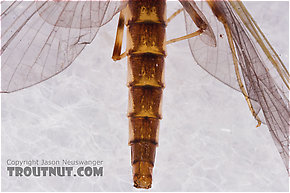 View 10 PicturesThis specimen is really strange, very different in form from any other mayfly I've seen. Unfortunately it was found alone crippled in an eddy and in pretty bad shape, and I couldn't find any others like it.
View 10 PicturesThis specimen is really strange, very different in form from any other mayfly I've seen. Unfortunately it was found alone crippled in an eddy and in pretty bad shape, and I couldn't find any others like it.
 View 10 PicturesThis specimen is really strange, very different in form from any other mayfly I've seen. Unfortunately it was found alone crippled in an eddy and in pretty bad shape, and I couldn't find any others like it.
View 10 PicturesThis specimen is really strange, very different in form from any other mayfly I've seen. Unfortunately it was found alone crippled in an eddy and in pretty bad shape, and I couldn't find any others like it.Collected June 28, 2005 from the Long Lake Branch of the White River in Wisconsin
Added to Troutnut.com by Troutnut on May 26, 2006
Added to Troutnut.com by Troutnut on May 26, 2006
Eurylophella temporalis (Chocolate Dun) Mayfly Nymph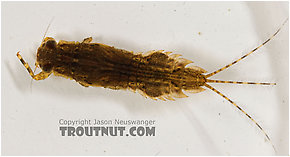 View 9 Pictures
View 9 Pictures
 View 9 Pictures
View 9 PicturesCollected June 5, 2005 from the Marengo River in Wisconsin
Added to Troutnut.com by Troutnut on May 25, 2006
Added to Troutnut.com by Troutnut on May 25, 2006
Agnetina capitata (Golden Stone) Stonefly Adult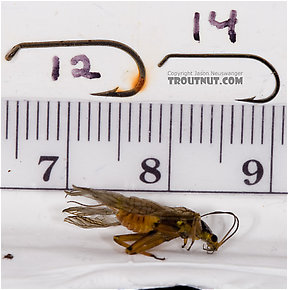 View 8 PicturesThis stonefly emerged in my aquarium, and unfortunately I severely damaged its wings just trying to catch it. It's still an interesting specimen, especially since I was able to also photograph the nymphal shuck (
View 8 PicturesThis stonefly emerged in my aquarium, and unfortunately I severely damaged its wings just trying to catch it. It's still an interesting specimen, especially since I was able to also photograph the nymphal shuck (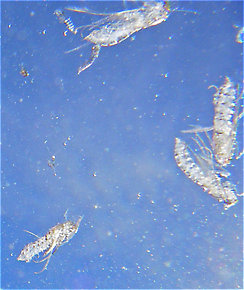 Shuck: The shed exoskeleton left over when an insect molts into its next stage or instar. Most often it describes the last nymphal or pupal skin exited during emergence into a winged adult.) it emerged from. I was surprised by just how light it was shortly after emerging. I photographed it a couple days later when it had darkened considerably; it was a pale, almost pastel yellow at first.
Shuck: The shed exoskeleton left over when an insect molts into its next stage or instar. Most often it describes the last nymphal or pupal skin exited during emergence into a winged adult.) it emerged from. I was surprised by just how light it was shortly after emerging. I photographed it a couple days later when it had darkened considerably; it was a pale, almost pastel yellow at first.
 View 8 PicturesThis stonefly emerged in my aquarium, and unfortunately I severely damaged its wings just trying to catch it. It's still an interesting specimen, especially since I was able to also photograph the nymphal shuck (
View 8 PicturesThis stonefly emerged in my aquarium, and unfortunately I severely damaged its wings just trying to catch it. It's still an interesting specimen, especially since I was able to also photograph the nymphal shuck (
Here's an underwater view of the pupal shucks of several already-emerged Brachycentrus numerosus caddisflies.
Female Baetisca laurentina (Armored Mayfly) Mayfly Spinner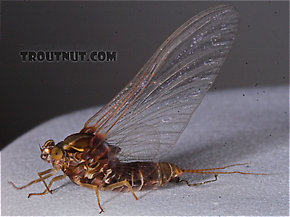 View 9 Pictures
View 9 Pictures
 View 9 Pictures
View 9 PicturesCollected June 1, 2005 from the Bois Brule River in Wisconsin
Added to Troutnut.com by Troutnut on May 24, 2006
Added to Troutnut.com by Troutnut on May 24, 2006
Sweltsa onkos (Sallfly) Stonefly Adult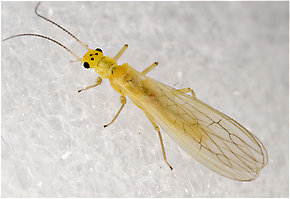 View 8 PicturesI'm just guessing this is Chloroperlidae, since it's little and yellow. If anyone has a less haphazard identification, feel free to post it.
View 8 PicturesI'm just guessing this is Chloroperlidae, since it's little and yellow. If anyone has a less haphazard identification, feel free to post it.
 View 8 PicturesI'm just guessing this is Chloroperlidae, since it's little and yellow. If anyone has a less haphazard identification, feel free to post it.
View 8 PicturesI'm just guessing this is Chloroperlidae, since it's little and yellow. If anyone has a less haphazard identification, feel free to post it.Collected May 15, 2007 from Mystery Creek #62 in New York
Added to Troutnut.com by Troutnut on May 18, 2007
Added to Troutnut.com by Troutnut on May 18, 2007
Chimarra (Little Black Sedges) Caddisfly Larva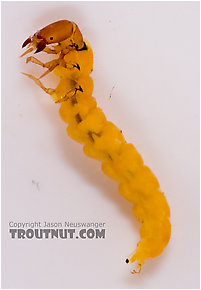 View 6 Pictures
View 6 Pictures
 View 6 Pictures
View 6 PicturesCollected March 30, 2007 from Fall Creek in New York
Added to Troutnut.com by Troutnut on April 2, 2007
Added to Troutnut.com by Troutnut on April 2, 2007
Ephemera simulans (Brown Drake) Mayfly Nymph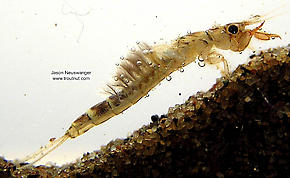 View 6 Pictures
View 6 Pictures
 View 6 Pictures
View 6 PicturesCollected January 31, 2004 from the Namekagon River in Wisconsin
Added to Troutnut.com by Troutnut on January 25, 2006
Added to Troutnut.com by Troutnut on January 25, 2006
Tallaperla (Roachflies) Stonefly Nymph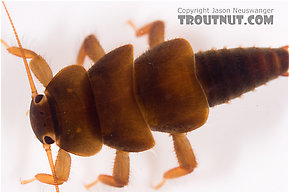 View 7 Pictures
View 7 Pictures
 View 7 Pictures
View 7 PicturesCollected April 1, 2007 from Mystery Creek #62 in New York
Added to Troutnut.com by Troutnut on April 3, 2007
Added to Troutnut.com by Troutnut on April 3, 2007
Epeorus vitreus (Sulphur) Mayfly Nymph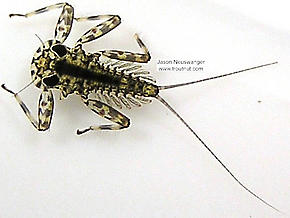 View 6 Pictures
View 6 Pictures
 View 6 Pictures
View 6 PicturesCollected February 7, 2004 from unknown in Wisconsin
Added to Troutnut.com by Troutnut on January 25, 2006
Added to Troutnut.com by Troutnut on January 25, 2006
Female Ephemera varia (Yellow Drake) Mayfly Dun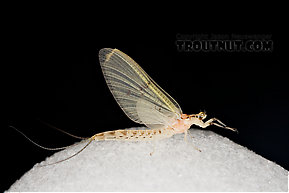 View 7 PicturesThis yellow drake dun hatched out of my aquarium over a month before her brethren in the wild are slated to emerge. She seems a bit small, and that might be the reason.
View 7 PicturesThis yellow drake dun hatched out of my aquarium over a month before her brethren in the wild are slated to emerge. She seems a bit small, and that might be the reason.
 View 7 PicturesThis yellow drake dun hatched out of my aquarium over a month before her brethren in the wild are slated to emerge. She seems a bit small, and that might be the reason.
View 7 PicturesThis yellow drake dun hatched out of my aquarium over a month before her brethren in the wild are slated to emerge. She seems a bit small, and that might be the reason.Top 10 Fly Hatches
Top Gift Shop Designs
Eat mayflies.
Top Insect Specimens
Miscellaneous Sites
Troutnut.com is copyright © 2004-2024 Jason
Neuswanger (email Jason). See my FAQ for information about use of my images.
 privacy policy
privacy policy
